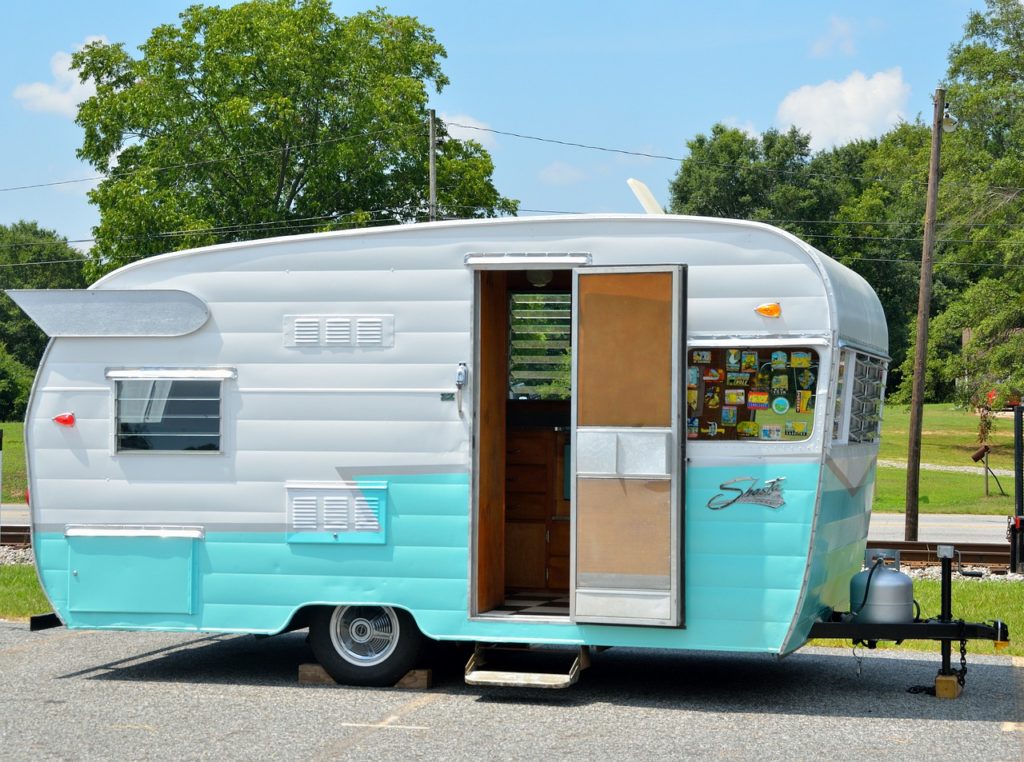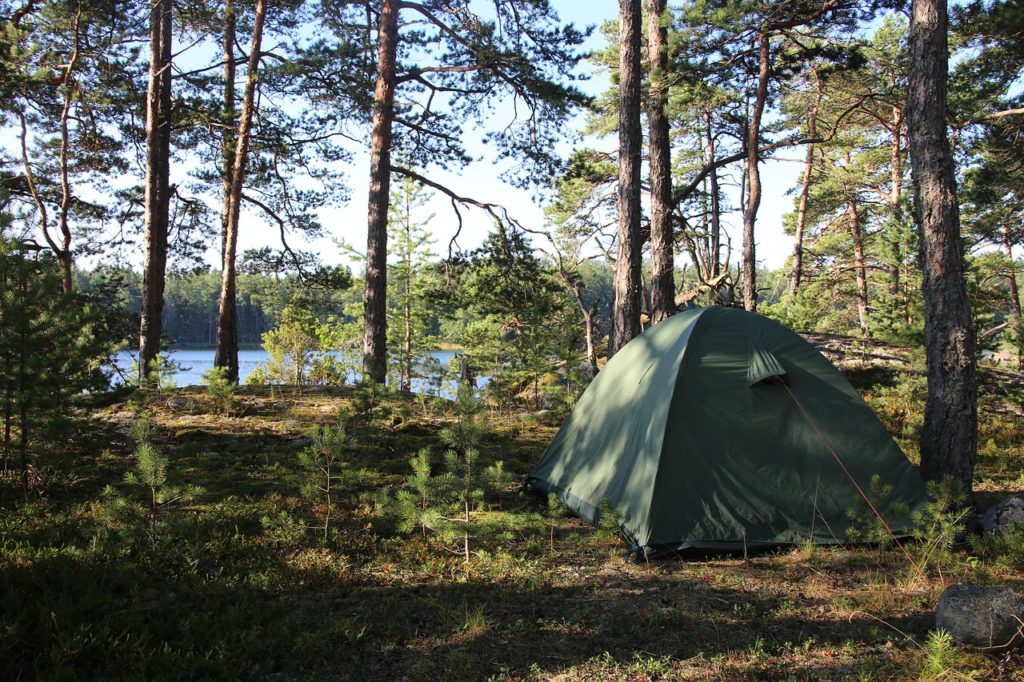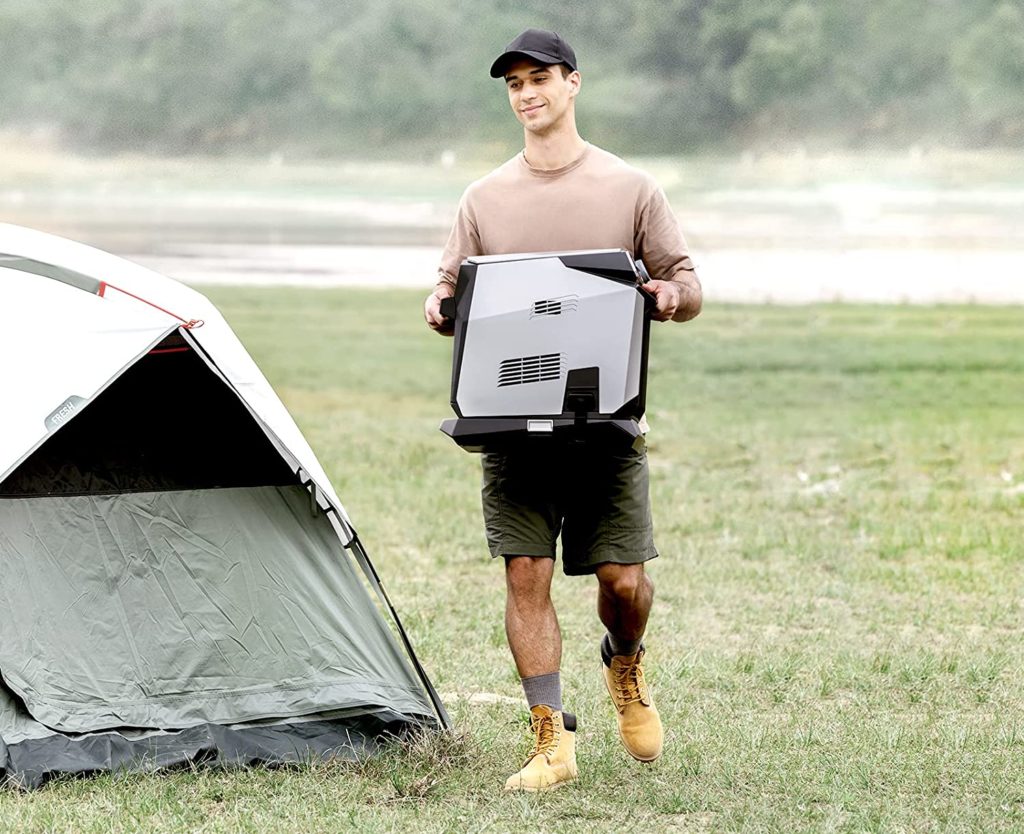Bringing along an air conditioner may not be an intuitive choice when you’re camping, but let’s face it, the great outdoors can get hot. Ever since people started “glamping,” the demand for tent air conditioners has increased. People want to experience the glory of nature and also sleep through the night in comfort. Can a battery-powered AC give you the best of both worlds? Let’s find out more.
Using Battery-Powered Air Conditioners to Cool Small Spaces
Battery-powered air conditioners can be used off-grid to cool small spaces like tents, campers, vans, and RVs. These portable air conditioning units can be dependable, cost-effective, and capable when they are properly installed and calibrated to suit your shelter and environment.
Advances in solar and battery technology have made outdoor climate control possible. However, a portable air conditioner must be matched or adapted to its environmental conditions to work well. Some lithium-ion-powered units can cool an enclosed space for several hours. Many batteries can be recharged at a conventional outlet or at a solar or fuel-powered charging station.
There are two categories of battery-powered air conditioners. Both kinds of machines cool air, but they work very differently, and each type is best suited to a particular set of environmental conditions. Evaporative coolers, also called swamp coolers, humidify air while moving it over cold water or ice. They work when humidity levels are under 50% and temperatures are at or above 80 degrees Fahrenheit. Air conditioners that use refrigerant and a rotary compressor (often coupled with an inverter) will cool and dehumidify air while venting hot air and water vapor through an exhaust. They can quickly lower the ambient temperature in a dry or humid enclosed space.
If you want to purchase a portable AC for camping, you’ll need to choose a model that is well suited to the type and size of your shelter and the humidity level at your campsite. When sourcing a camping AC for a tent, you’ll also need to consider how easily light, heat, and air can pass through the tent’s fabric walls.
- Fast Cooling. With a 4,000BTU cooling capacity, Wave cools spaces faster than other portable air conditioners. Ideal for tents, RVs and small off-grid spaces.
- Four Ways to Charge. With a 1008Wh add-on battery, Wave is truly portable. The same goes for charging methods. Charge with solar, your car socket, or a portable power station. Add on a DELTA Max/DELTA Pro and extend run times to a record-breaking 6-12hrs - that's 28% more efficient than other power stations. And of course, you can top up at home via a wall outlet too.
- Control from Afar. Use the EcoFlow app to control the air conditioner from afar or completely customize how you use it. Prioritize extended 8hr run times with eco mode or get bursts of maximum cooling for hours on end. It's a portable air conditioner that's smart, and powerful.
- Powerful & Portable. Replace your RV air conditioner with one that's powerful and portable. Attach tubing for efficient cooling and carry it anywhere for a flexible approach to keeping comfy. Wave redefines the portable ac air conditioner category.
- No Water Left Behind. Unlike other portable air conditioners, Wave evaporates excess water. That means no water is left behind in typical environments. It also means minimal maintenance for your cooling setup.
An evaporative cooler needs a continuous supply of fresh air to operate, while a compressor air conditioner works best in an insulated and relatively airtight tent or camper. To ensure you stay cool for several hours, you will need to do a fair amount of planning and preparation. Here are some tips to help you get started.
Take Stock of Your Campsite
Do you camp in the mountains, the desert, or in a subtropical climate? If you visit campsites with humidity levels of over 50%, choose a compressor air conditioner.
Measure Your Space

The battery-powered portable air conditioners available today are designed to cool small spaces between 25 and 86 square feet. If the footprint of your shelter is too large, your air conditioner may struggle or fail to cool the space. Although it might be possible to use multiple air conditioning units to cool a larger space, it will not be cost-effective or efficient.
Calculate the Number of British Thermal Units (BTUs) Required
While it can be tricky to select an air conditioner for a camper, these shelters have the advantage of being sealed off from the elements. An air-conditioned tent might be an energy-efficiency engineer’s nightmare. For a variety of reasons, it can be difficult to optimize your space for air conditioning. At best, most consumers make inexact estimates about the amount of cooling power they need. Nevertheless, you should make a few basic calculations to see if a battery-powered portable air conditioner can work for you.
The top battery-powered portable air conditioners on the market today have cooling capacities that range between 2,300 and 4,000 BTUs per hour. The numerical BTU rating tells you how much heat the machine can remove from the air in 60 minutes. The BTU represents the amount of energy needed to raise 1 pound of water 1 degree Fahrenheit. When you use BTUs to estimate changes in air temperature, one BTU will change the temperature by 1 degree per 55 cubic feet of air.
Humidity, air pressure, elevation, and heat-generating human bodies are all variables that can affect the temperature of a space, making measurement of heat inputs and exact calculation of necessary cooling power enormously complex. It’s much more common to use rough guidelines like “20 BTUs per square foot” or “five BTUs per cubic foot” to estimate how much cooling power you need. If you can find the volume of your tent in cubic feet, multiply it by five and then add 600 BTUs for each person who will be in the tent. This will give you an estimate of the number of BTUs you need. Use an online BTU calculator to account for additional heat-related variables.
The more accurate your estimate, the more likely you will be able to select a suitable air conditioner for your tent. An underpowered air conditioner will never sufficiently cool the space, while an overpowered air conditioner will short cycle and shut off before cool air can fully circulate.
Calculate the Amount of Power Your Air Conditioner Requires
If you know the volume of your space and the cooling capacity you need, you can calculate how much power it will take to run your air conditioner continuously for an hour. If you are using a battery or a power station, the capacity of your power source will determine how long you can run your machine.
Efficiency and performance can be reduced by additional heat inputs that force the compressor to work harder to cool the space. If you use your portable battery-powered air conditioner in particularly sunny, hot, humid conditions in a poorly sealed space, your power source will drain more quickly.
Identify Your Power Sources

All compressor-based air conditioners require an alternating current or direct current power source. Most portable air conditioners can be powered by a 24-volt battery, a 12-volt or 24-volt lithium-ion power station, or a 110-volt or 220-volt generator.
Portable battery-powered air conditioners typically operate at 240–460 watts. If the shelter is poorly insulated or sealed, filled with humid air, or in bright sunlight, the compressor may draw more current to compensate for the heat transfer. An overworked compressor will consume more power and drain the battery faster.
Most air conditioning units can run at full capacity for two to three hours. Spent batteries need to be recharged or replaced. Generally speaking, portable battery-powered air conditioners offer a variety of charging options to make them practical for an extended trip off-grid. Fuel-powered generators or solar panels can be used to recharge batteries and power stations. If your vehicle is properly equipped, you can charge your battery while you’re driving. If you’re at a campsite, you may be able to plug your battery into an AC charging station. Look at the owner’s manual to check for compatibility requirements.
Insulate Your Shelter
Most tents allow air to pass through them, so they must be shaded, sealed, and insulated to keep cool air inside. Pitching your tent in a shady area surrounded by trees will prevent it from being heated by direct sunlight. A reflective tarp, sunshade, or insulated solar blanket can also reflect heat away from the exterior surface of the tent to help keep the inside air cool. If the ground is hot where you are camping, an insulating layer between the ground and the tent can trap heat under the tent and prevent the inside temperature from rising.
Install and Operate Your Air Conditioner
Portable battery-powered air conditioners typically have exhaust hoses to contain and direct hot air away from the chilled area. You will probably need to cut a hole in your tent to vent hot air outside. Place the exhaust hose through the hole, and then seal the opening between the hose and the tent.
You may also need extra conduit, pipe, and a bucket to drain water away from your air conditioning unit. If the air is especially humid, water may condense at the bottom of the unit. Most portable battery-powered air conditioners account for this circumstance and include instructions for dealing with this extra water.
Account for the Size of Your Air Conditioning System
The footprint of a battery-powered air conditioner is usually under 2 cubic feet, which is a fairly small amount of space. Once you account for exhaust hoses, extra battery packs, power stations, or generators, you may find you need more room than you anticipated. Also, make sure to account for the amount of space taken up by gear and supplies so you can rest comfortably in your tent.
5 Best Portable Power Stations for Camping
Keep Your Shelter Quiet
Compressors and fans that are poorly designed or overworked may produce an excessive amount of noise. Fortunately, the portable battery-powered air conditioners available today are relatively quiet. Noise is rated in decibels (dB), and the average unit usually operates at around 55 dB, which is about as loud as light traffic or a coffee maker.
Once you have determined that your chosen air conditioner and power supply will fulfill your needs, you can review your budget and space requirements. Portable battery-powered air conditioners are relatively expensive and usually require the purchase of an add-on battery or power station to be practical, which can double the price. A fully accessorized portable air conditioning system will cost you thousands of dollars. An underpowered system could be worse than no system at all because it will give you no value for your money. Make sure you can afford all the components you need before purchasing your system.
Choose an Evaporative Cooler as an Alternative for Arid Climates
If your camping is limited to arid climates, an evaporative cooler may be the best climate-control option for your shelter. You won’t need to seal or insulate your shelter because evaporative air coolers work well in open spaces. Because they use a fan to move air over water or ice, they generally use less than half the energy of a portable battery-powered air conditioner. Evaporative coolers are easy to maintain, cost much less than a portable battery-powered air conditioner, and have minimal environmental impact. As long as you have ready access to water, an evaporative cooler will be space efficient.
Evaporative coolers work by replacing lighter, hotter, and drier air with cooler, heavier, and more humid air. A capable, properly sized swamp cooler can completely replace the warm air in the room and lower the temperature by as much as 33 degrees Fahrenheit. Cooling capacity, a function of airflow, is measured in cubic feet per minute (CFM). For shelters under 250 square feet, you need a cooler rated at 300–750 CFM.
Most commercially available swamp coolers that are powerful enough to cool a tent run on alternating current, so if you choose to use one, you will need to bring along a portable generator. It is also possible to create a battery-powered swamp cooler by using a battery-operated fan to blow air over ice.
An Air Conditioner Can Make Your Camping Trip Comfortable and Luxurious
Battery-powered portable air conditioners are an innovative solution to keeping cool when you are camping. Although the current models can be pricey, they can offer luxurious climate control to summertime campers everywhere. As prices for solar panels and battery storage decrease, battery-powered air conditioners are likely to rise in popularity and become more advanced. Whether you choose a compressor-based air conditioner or an evaporative swamp cooler, these machines give you the ability to camp in comfort.


